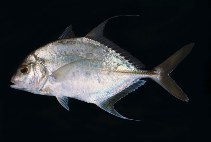| Family: |
Carangidae (Jacks and pompanos), subfamily: Caranginae |
| Max. size: |
85 cm TL (male/unsexed); max.weight: 2,600.0 g |
| Environment: |
reef-associated; brackish; marine; depth range 1 - 80 m |
| Distribution: |
Indo-West Pacific: East Africa to Samoa, north to southern Japan, south to Tonga. |
| Diagnosis: |
Dorsal spines (total): 9-9; Dorsal soft rays (total): 17-19; Anal spines: 3-3; Anal soft rays: 15-17. Description: Bluish green above, silvery white below; small dark blotches on back between bases of dorsal rays (Ref. 3197). LL with 23-30 scutes. Characterized by a series of small black rectangular spots at base of soft dorsal fin and dark anal fin (Ref. 37816). With diffuse brown blotch posteriorly on opercle, and yellowish upper caudal fin lobe (Ref. 90102). No filament on anal fin (Ref. 48635). Body nearly ovate, strongly compressed; nape slightly elevated, almost straight in profile. Breast scaleless ventrally only to origin of pelvic fins. Both jaws with bands of small teeth, widest anteriorly; upper jaw also with irregular outer series of moderately large teeth. (Ref. 90102) |
| Biology: |
Adults inhabit coastal waters. They occur singly or in small to large schools (Ref. 90102) at a depth of 15 m or less along steep drop-offs. Piscivore (Ref. 97629). Maximum depth reported taken from Ref. 128797. |
| IUCN Red List Status: |
Least Concern (LC); Date assessed: 06 March 2015 Ref. (130435)
|
| Threat to humans: |
harmless |
Source and more info: www.fishbase.org. For personal, classroom, and other internal use only. Not for publication.
